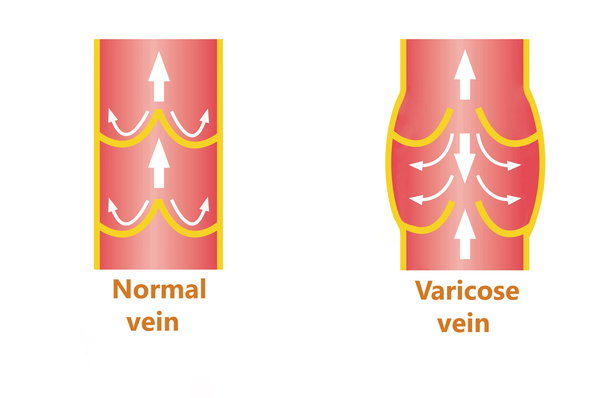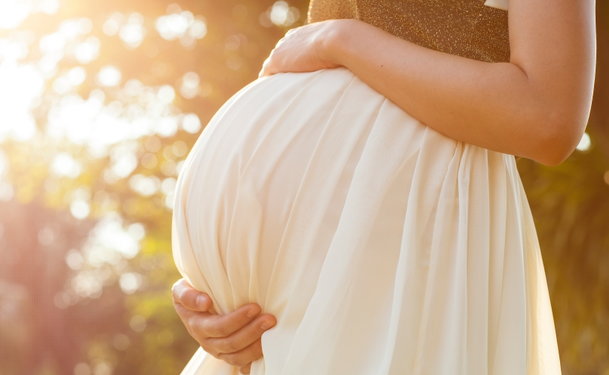If you are pregnant and have varicose veins, you are not alone. These swollen, twisted veins are a common occurrence during pregnancy. Sometimes they will go away by themselves after you give birth, but they can stick around much longer.
Learn how pregnancy affects your vein health, how to reduce varicose vein symptoms during pregnancy, and how you can have varicose veins treated to make your next pregnancy more comfortable.
How is pregnancy linked to varicose veins?
Varicose veins are swollen, twisted veins that you can see under the skin. They usually appear blue or red. They often occur in the legs, but can also appear on other parts of the body. if you are pregnant, you may even experience vaginal varicose veins, or "vulvar varicosities."
Varicose veins are caused when the valves or walls of your veins don’t work properly. In healthy veins, valves help to push the blood back up to your heart. In unhealthy veins, the valves are weak. This allows blood to flow backward and pool in the vein creating a condition known as chronic venous insufficiency (CVI). This gives varicose veins their swollen look.

Pregnancy does not cause varicose veins, but it can increase your risk of developing them for several reasons:
- Increased blood volume. During pregnancy, your body increases the amount of blood in your arteries and veins in order to nurture your growing baby. This puts more pressure on the veins of your legs, which causes the veins to stretch.
- Increased pressure in the abdomen and pelvis from the baby. As your baby grows, the pressure in your abdomen and pelvis increases, which makes it harder for blood in the veins to flow from the legs to the heart.
- Increased hormones. The hormones that your body needs for a healthy pregnancy—estrogen and progesterone—can also weaken the walls of your veins. This makes it easier for them to become swollen with extra blood and increased pressure.
- Decreased physical activity. During pregnancy, you may move around less, which increases your risk of developing varicose veins. This one is true for everyone, not just pregnant women.
- Weight gain. Carrying around extra weight increases the pressure on your veins, especially the veins in your lower legs.
Common symptoms of varicose veins
Varicose veins often show up in the third trimester. You may find that your varicose veins appear earlier with subsequent pregnancies.
The most common symptoms of varicose veins in the legs include:
- Swollen, twisted veins visible just under your skin
- Mild swelling in your feet and ankles
- Achy, painful or heavy-feeling legs
- Cramping or throbbing in your legs
- Itchy legs, often on the ankle and lower legs
- Change in the color of the skin around the varicose vein
Some of these symptoms can be caused by other, more serious conditions. Contact your doctor if the symptoms persist or worsen.
Do varicose veins go away after pregnancy?
Varicose veins will sometimes clear up within a year after giving birth but can last longer or not go away at all. "After the first pregnancy, they very often resolve. During the second and subsequent pregnancies, the valves are damaged and do not keep the blood flowing normally," according to Dr. Norman N. Bein FACS of Vein Specialties of St. Louis.
As far as preventing varicose veins in future pregnancies, Dr. Bein recommends an evaluation with a vein specialist. "This would best be done after your hormones return to normal after delivery and breastfeeding," he advises.
Some physicians recommend treating your varicose veins in between pregnancies to make your later pregnancies as comfortable as possible, while others recommend fixing them once you are done having children.
Managing varicose veins during pregnancy
There are a number of in-office medical treatments geared toward removing varicose veins. These treatments use laser energy or a chemical solution to collapse varicose veins and therefore reroute blood flow to healthy veins. However, those treatments will be off-limits until after your pregnancy.
In the meantime, there are several natural ways that you can reduce the symptoms of varicose veins during pregnancy, such as:
- The major preventive measure is to exercise and walk. Stay as active as possible.
- Avoid sitting or standing still for a long time.
- Elevate your legs above the level of your heart for at least 15 minutes several times a day.
- Avoid wearing tight clothing around your legs, thighs, and waist. In particular, avoid tight clothing that can compress the waist or groin. These can make it harder for blood to flow from the legs.
- Wear compression stockings to help push the blood back up your legs. These are available from pharmacies and medical supply stores.
- If you cross your legs, notice whether that makes your varicose vein symptoms worse. If so, avoid crossing your legs. Often, crossing your legs is just a sign that you are sitting still for too long.
- During pregnancy, you should always lie on the left side with the legs elevated on a pillow. This prevents the fetus from pressing on the leg veins and decreases the chance of developing varicosities.
- Control your weight.
- Eat a low-salt diet (salt does have the ability to retain water).
Treating varicose veins before or after pregnancy
If your varicose veins remain long after you give birth, or if they caused a lot of discomfort during your pregnancy, you can have them treated before your next pregnancy.
Modern treatments for varicose veins include:
- Foam Sclerotherapy. A special chemical is injected into the vein to cause scarring. The vein then collapses and eventually fades away.
- Endovenous ablation therapy. A small tube (catheter) is inserted into your vein through a cut in your skin. A laser or radiofrequency radiation is used to heat and close off the vein. The vein will fade over time.
- Ambulatory phlebectomy. The vein is removed with a special hook through several small cuts in the skin.
Vaginal varicose veins during pregnancy?
Varicose veins are generally more prominent in the legs but during late pregnancy, they may develop near the vulva or vagina. The major reason is that you retain a lot of weight and fluid during pregnancy. In addition, the baby in utero may also compress some parts of the pelvis (lower abdomen) and lead to engorgement of the veins in the vulva/vagina. If you have varicose veins of the vulva during pregnancy, you will always have varicosities of the legs at the same time.
Some women report a related condition of pelvic pain, which in some cases may be related to varicose veins of the pelvic region. While not well understood, physicians from different backgrounds are trying to better understand pelvic varicose veins and how they contribute to pelvic pain.
How can varicose veins be diagnosed?
Varicose veins can usually be diagnosed by a simple physical examination and the use of Doppler ultrasound. This painless test assesses the valve function in the groin and can also determine how much blood is flowing back into the legs. The test can also determine the presence of blood clots in the veins.
Are varicose veins serious?
In the majority of cases, varicose veins are of a cosmetic nuisance. When the legs are involved, the following can develop:
- Constant itching
- Pigmentation around the ankles
- Ulcers at the ankles
- Mild swelling of the feet
- Occasional blood clots in the veins
- Infection of the vein
Do varicose veins develop clots?
Yes, but unlike the deep veins of the leg, the clots formed in the varicose veins rarely move to the lungs. The blood clots in varicose veins remain in one place and are often the cause of tenderness and itchiness. There is no need to take blood-thinning medications when clots are found in the varicose veins.
What problems can occur if varicose veins are left untreated?
Most people with varicose veins do not develop complications. It is impossible to predict who will develop complications. The size of the varicose vein is not related to complications but the duration of the varicose vein is. Complications that may occur include:
- Superficial thrombophlebitis - in this condition, the varicose vein is inflamed and tender. A clot is usually present in the vein.
- Bleeding - even with minor trauma, the varicose vein may be associated with bleeding. Because the vein is under high pressure, the bleeding can be quite profuse.
- Venous eczema - the skin around the vein may become dry and very itchy.
- Venous pigmentation - this is brown staining of the skin around the ankle. It is due to the leakage of a small amount of blood from the veins into the skin.
- Venous ulceration - ulcers at the ankle.
Can varicose veins return after treatment?
Yes, unfortunately, there is no cure for this disease. Only complete stripping of the large superficial veins in the leg can completely remove the vein. In addition, the branches must also be removed otherwise recurrence will occur. When the large vein has been removed, only small spider veins can occur. To prevent recurrence of varicose veins, the best therapy is exercise and wearing compressible hose stocking.
Is varicose vein surgery covered by insurance?
Depends, if one has symptoms of leg swelling, pain, ulcers or clots, then all medical insurance and even Medicare covers the cost of treatment. However, if the surgery is done purely for cosmetic reasons, then the cost of the procedure is not covered.


